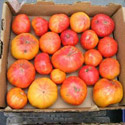A Choice Tomato
September 15, 2006
 This week’s feature was written by CUESA volunteer Amy DerBedrosian.
This week’s feature was written by CUESA volunteer Amy DerBedrosian.
Whether or not there’s any truth to the centuries-old notion that the tomato is an aphrodisiac, there’s a lot to love about the varieties of tomatoes available at farmers’ markets today. In red, yellow, green, shades between, speckles, and stripes, tomatoes at their peak production present seemingly too many choices. The names of the varieties are equally intriguing and colorful: Black Prince, Early Girl, Mortgage Lifter, Green Zebra, Ivory Pear, Pineapple. These are only a few of the possibilities. Ed George of The Peach Farm, who grows more than 100 varieties himself, says he’s seen lists of at least 500 heirloom tomato varieties.
Farmers’ market shoppers have help with the dilemma of abundance: the person who grew the tomatoes is often there to answer questions and offer advice on selection. When asked which tomato is best, Bill Crepps of Everything Under the Sun responds with a question of his own: What are you going to do with it?
For slicing, he suggests the Marvel Stripe, a meaty tomato. For a strong-flavored sauce, Crepps advises, “You can’t beat an Early Girl.” That’s also his pick for gazpacho. The Early Girl, he says, gives the soup its classic, sharp tomato flavor.
Crepps acknowledges that customers often gravitate toward heirloom tomatoes, viewing these open-pollinated varieties as traditional and authentic. In response, seed companies have made more heirlooms available to farmers. But there simply isn’t a “best-tasting” tomato. As The Peach Farm’s George says, “You take 100 people, and they’re all going to like a different one. The tomatoes are all good in their own way.”
After deciding on a variety, there’s still the matter of selecting individual tomatoes. Instinct can prove misleading. Crepps explains, “With heirlooms, a lot of people go by color. But you can tell how ripe they are by feel. Tomatoes get soft when ripe. You can’t go by color.”
 Both Crepps and George farm in Winters and find Yolo County’s soil rich, slightly heavy, and good for tomatoes. Crepps says hot days that don’t cool much at night also help. Of course, Northern California’s unusual weather this year resulted in some challenges and changes. First came heavy spring rains and what George describes as a “dismal start” for tomatoes. Phased planting dates were delayed. Later, below-normal temperatures followed a triple-digit July heat wave. The fluctuations called for adjustment to the even watering that produces tomatoes that are neither too soft nor subject to cracking. And consumers waited an extra month for tomatoes at the farmers’ market. Fortunately, George reports, the tomatoes “snapped out of it, and it turned out to be a good year.”
Both Crepps and George farm in Winters and find Yolo County’s soil rich, slightly heavy, and good for tomatoes. Crepps says hot days that don’t cool much at night also help. Of course, Northern California’s unusual weather this year resulted in some challenges and changes. First came heavy spring rains and what George describes as a “dismal start” for tomatoes. Phased planting dates were delayed. Later, below-normal temperatures followed a triple-digit July heat wave. The fluctuations called for adjustment to the even watering that produces tomatoes that are neither too soft nor subject to cracking. And consumers waited an extra month for tomatoes at the farmers’ market. Fortunately, George reports, the tomatoes “snapped out of it, and it turned out to be a good year.”
That pleases the farmers, and not just for business reasons. Like most people, they want to eat a flavorful tomato that’s traveled from farm to market in only a day. “If you haven’t had a vine-ripened tomato and are just eating tomatoes from the stores, you’re missing out,” says George.
Topics: Fruit, Vegetables
